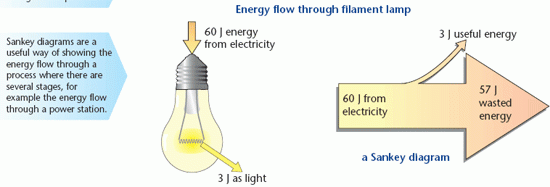Energy & a Filament Lamp
When a filament lamp is switched on, some energy is absorbed by the filament as it reaches its operating temperature. This takes a fraction of a second. Some energy is absorbed by the glass envelope and the gas inside. These take a little longer to reach a steady temperature, perhaps a few seconds.
Once the lamp has reached its steady state, of the 60 J of energy passing into the lamp each second from the electricity supply, typically 3 J passes out as light. This is shown in the diagram. The Sankey diagram gives a visual indication of the relative proportions of energy transferred into a desirable output and wasted.

In the steady state, the parts of the lamp are emitting energy and absorbing energy at the same rate, so there is no change in temperature.
The ‘wasted’ energy is transferred to the surroundings in two main ways:
- from the glass envelope to the surrounding air by conduction and convection
- from all parts of the lamp as non-visible electromagnetic radiation (mainly infra-red).
The light and the infra-red radiation both cause heating when they are absorbed,
so all the energy input to the lamp ends up as heat!
These examples illustrate some important points about energy transfer:
- energy due to movement is called kinetic energy
- energy due to position above the Earth’s surface is called gravitational potential energy, often abbreviated to potential energy
- work usually involves some transfer of energy to the surroundings.
